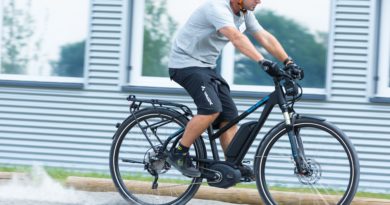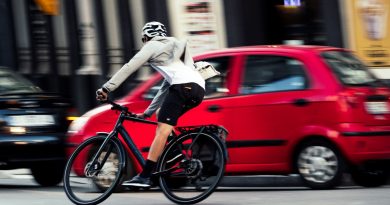Highway engineer on bike lanes: “The street is not too narrow, your imagination is”
Life as highway engineer who cycles can be tough. In a guest appearance, Twitter’s @RantyHighwayman explains to those opposing cycling infrastructure “The street is not too narrow, your imagination is too narrow…”
What is it about the simple act of using a cycle to travel from A to B that sends some people into a frothing rage? Why is it so hard to redesign our roads and streets to make them more people-focused? Why do politicians do everything in their power to maintain the car-centric status quo, despite the continual evidence that walking and cycling provide so many positive economic, health and social impacts in communities where people have genuine choices over how they travel? Why does all this happen when we know that redesigning our streets is actually a very popular thing to do? Well, I am not sure I have the answers, but I’ll happily give opinions to anyone who will listen.
 Our highway law has developed in a way which indirectly favours driving and any change to that must be modified either at a national or local level.
Our highway law has developed in a way which indirectly favours driving and any change to that must be modified either at a national or local level.
For example, the 30mph speed limit in built up places and the National speed limit are both national approaches (with the devolved administrations also having powers) whereas local changes are created through the use of traffic orders. A consequence of this is that streets are by default two-way, open to all classes of traffic unless modified, have an urban 30mph speed limit unless modified, are free to park cars on and so forth.
Changes have to be made through a local process and so dealing with this basic status quo always comes at a cost (financially and politically) which immediately means there’s no level playing field. As soon as people drive in sufficient numbers or speeds above 20mph, everyone else is chased off the street.
The political side of this is interesting and frustrating in equal measure. On the one hand, we have national Governments saying that they are putting active travel first, but it’s not about what they are saying, it’s about what they are doing (or maybe funding). The Westminster government keep (re)announcing bits and pieces of a planned £5bn investment in walking, cycling and buses, yet it is pushing on with a £27bn investment in road building (although this does include major maintenance works). The other administrations are similarly duplicitous at talking about investment in non-car modes while intensively funding road schemes, although maybe there’s some change in the wind with Wales rejecting the widening of the M4 and bringing in a default 20mph speed limit for built up areas.
We also need to talk about how we approach transport and especially spatial planning. If we design places where people have little choice but to drive for their day-to-day needs, then we have failed on two levels. First, it will mean that many people won’t have an alternative mode of transport because they can’t or won’t drive. Second, if we do then want to come in and change things, we are having to invest even more into trying to unpick what has gone before.
Decisions are often framed in policy and this is no different for transport and spatial planning. Despite reforms over the years, we are still stuck in a cycle of planning for future scenarios which assume motor traffic growth and this influences public discourse where the need to protect people’s ability to drive trumps all else. Planning policy at all levels does talk grandly of putting a people-based user hierarchy in place, but delivery on the ground is rare. It is often the case that a developer will be proposing a scheme which has an impact on local traffic (usually at junctions) and so the local highway authority (through the planning authority) will push for capacity upgrades which further lock in our historic problems.
There are reasons to be optimistic though. There are pockets of hope across the country where local politicians and officers (who have political backing) are starting to change the debate and more importantly, change is happening on the ground. It’s obvious, but the London Borough of Waltham Forest has been doing a great deal over the last several years through its Mini-Holland program where main roads have been furnished with cycle tracks and side streets have had through traffic removed. We’re seeing change in other parts of London including Hackney, Enfield and Southwark to name a few. It is as if these places reach a tipping point (even if they were traditionally friendly towards non-car modes).
One the most exciting places for me is Greater Manchester. Despite being a Londoner where some great stuff has been going on, I look across with envy at the processes adopted in GM with the community-level engagement process which led to the Bee Network plan and the approach taken by walking & cycling commissioner, Chris Boardman, who has essentially said that if people don’t want change, that’s fine, and he’ll concentrate on working with the willing. It has taken a couple of years, but this ground-up approach is now paying dividends on the street with a steady pipeline of projects being delivered across GM.
So, what can the cycling industry do to help?
Far be it from me to tell you all how to run your businesses, but I have some ideas you may wish to think about. I cycle mainly for utility and to be honest, the latest piece of electronic gadgetry or grams shaved from a saddle are not going to cut it with people like me. My usual machine is an upright, heavy step-through Dutch bike with hub gears, mudguards, an enclosed chain, pannier rack, wheel lock and dynamo lights. Trying to sell me a set of lights for a couple of hundred quid, performance bib shorts or wheels costing twice as much each as my bike was new isn’t going to tempt me.
 My point is that we know cycling is a broad church, but there really isn’t enough people making decent utility cycles and coupled with technical clothing, this feeds the imagery around cycling being some odd pursuit. I’ve no problem with sport and leisure cycling, but to many who might fancy starting to cycle for transport it all looks complicated and daunting where all people want to do is jump on something comfortable with everything they need built onto their cycle.
My point is that we know cycling is a broad church, but there really isn’t enough people making decent utility cycles and coupled with technical clothing, this feeds the imagery around cycling being some odd pursuit. I’ve no problem with sport and leisure cycling, but to many who might fancy starting to cycle for transport it all looks complicated and daunting where all people want to do is jump on something comfortable with everything they need built onto their cycle.
Next, perhaps the industry needs to be vocal in support for changes to our streets and roads. The Bike is Best campaign over the summer was great. It showed that for every person against change, there were six-and-a-half supporting it. Such data is powerful when trying to influence politicians and public opinion. We have some very noisy and influential people who object to anything challenging the status quo and it drowns out the positivity; so the campaign was so refreshing to see.
Allied to both this and the issue of the availability of utility cycles is the imagery that is used, because as with the motor manufacturers we are all trying to sell people a vision and for utility cycling, it is a vision where people can just get out to meet their everyday transport needs using nice streets and not having to worry about traffic. With the industry backing such an accessible way of life, they are going to have customers pushing at an open door.



